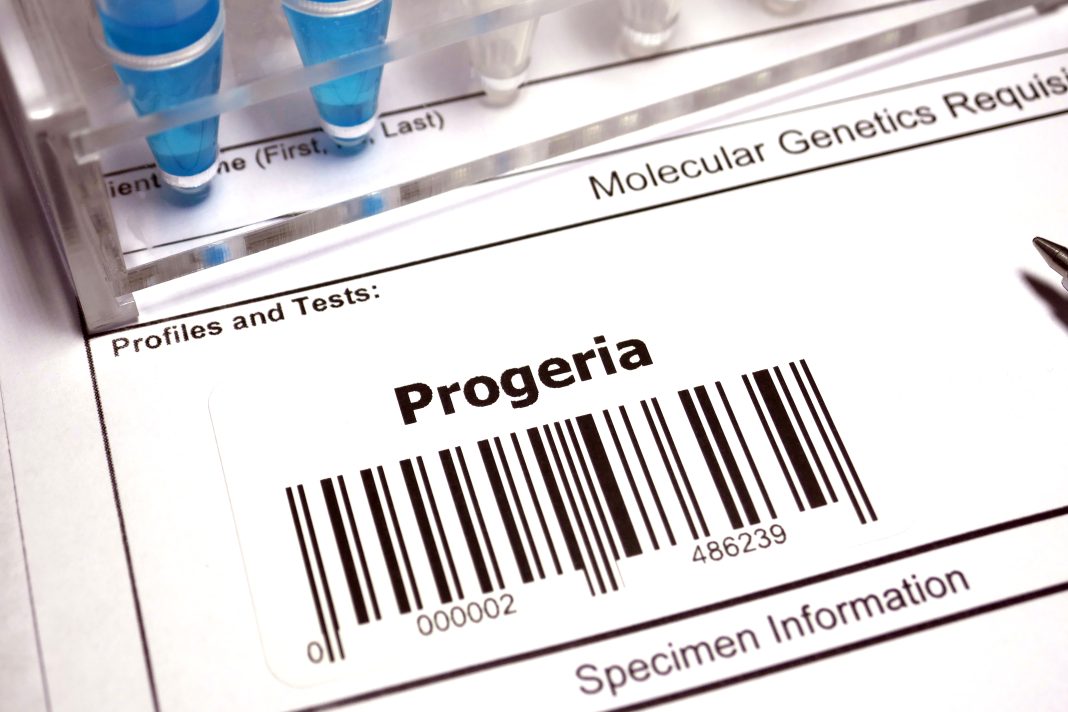Researchers at the Salk Institute and King Abdullah University of Science and Technology (KAUST) in Saudi Arabia say they have discovered that a DNA segment that jumps around the human genome plays a role in premature aging disorders. In people with early aging, or progeria, RNA encoded by this mobile DNA builds up inside cells. What’s more, the scientists found that blocking this RNA reverses the disease in mice.
The findings are published in a study (“LINE-1 RNA causes heterochromatin erosion and is a target for amelioration of senescent phenotypes in progeroid syndromes”) that appears in Science Translational Medicine and focuses on a piece of RNA known as LINE-1.
Constitutive heterochromatin is responsible for genome repression of DNA enriched in repetitive sequences, telomeres, and centromeres. During physiological and pathological premature aging, heterochromatin homeostasis is profoundly compromised. Here, we showed that LINE-1 (Long Interspersed Nuclear Element-1; L1) RNA accumulation was an early event in both typical and atypical human progeroid syndromes,” the investigators wrote.
“L1 RNA negatively regulated the enzymatic activity of the histone-lysine N-methyltransferase SUV39H1 (suppression of variegation 3-9 homolog 1), resulting in heterochromatin loss and onset of senescent phenotypes in vitro. Depletion of L1 RNA in dermal fibroblast cells from patients with different progeroid syndromes using specific antisense oligonucleotides (ASOs) restored heterochromatin histone 3 lysine 9 and histone 3 lysine 27 trimethylation marks, reversed DNA methylation age, and counteracted the expression of senescence-associated secretory phenotype genes such as p16, p21, activating transcription factor 3 (ATF3), matrix metallopeptidase 13 (MMP13), interleukin 1a (IL1a), BTG anti-proliferation factor 2 (BTG2), and growth arrest and DNA damage inducible beta (GADD45b).
“Moreover, systemic delivery of ASOs rescued the histophysiology of tissues and increased the life span of a Hutchinson-Gilford progeria syndrome mouse model. Transcriptional profiling of human and mouse samples after L1 RNA depletion demonstrated that pathways associated with nuclear chromatin organization, cell proliferation, and transcription regulation were enriched. Similarly, pathways associated with aging, inflammatory response, innate immune response, and DNA damage were down-regulated.
“Our results highlight the role of L1 RNA in heterochromatin homeostasis in progeroid syndromes and identify a possible therapeutic approach to treat premature aging and related syndromes.
“These findings provide new insight into progeroid syndromes and how to treat them, while also highlighting the importance of LINE-1 RNA in normal aging,” said co-corresponding author Juan Carlos Izpisua Belmonte, PhD, a professor in Salk’s Gene Expression Laboratory and director of the Altos Labs San Diego Institute of Science.
Progeroid syndromes, which include Hutchinson-Gilford progeria syndrome and Werner syndrome, cause accelerated aging in children and adolescents. Patients develop not only striking physical appearances but also symptoms and diseases typically associated with older age, such as heart disease, cataracts, type 2 diabetes, osteoporosis, and cancer. There are currently no effective treatments for progeroid syndromes.
Altered overall organization of DNA
Izpisua Belmonte and his colleagues knew that one of the molecular signatures of both normal aging and progeroid syndromes is the altered overall organization of DNA. When DNA is packaged differently into the nuclei of cells, it changes which genes are accessible for the cell to use and can therefore drastically change a cell’s behavior and function.
Scientists also knew that human genomes contain hundreds of LINE-1 elements that propagate and move around the genome, as well as encode LINE-1 RNA. The function of these elements is poorly understood, but they change and multiply with age, as well as in diseases including cancer and cardiovascular disease. Izpisua Belmonte’s team wondered whether they also changed in progeroid syndromes.
“The repeat sequences like LINE-1 make up a large percentage of our genomes, but not much attention is paid to the effects of LINE-1 RNA that increase with age in the nuclei,” said co-first author Pradeep Reddy, PhD, a former Salk staff scientist and current principal scientist at Altos Labs.
The researchers studied cells derived from patients with progeroid syndromes and found that they had four to seven times more LINE-1 RNA than cells from healthy individuals. Moreover, they showed that the accumulation of LINE-1 RNA came before the major structural changes to DNA that were already associated with progeria.
The team then developed molecules that could specifically bind to LINE-1 RNA, preventing the RNA from accumulating and impacting the cells. This kind of treatment reversed the molecular signs of progeria in isolated cells and extended the life span of mice with genetic mutations that typically cause premature aging.
In both cases, the expression of genes associated with cell proliferation and DNA structure increased after treatment, while the expression of genes associated with aging, inflammation, and DNA damage decreased.
“Targeting LINE-1 RNA may be an effective way to treat progeroid syndromes, as well as other age-related diseases that have been connected to LINE-1, including neuropsychiatric, eye, metabolic disorders, and cancers,” said Izpisua Belmonte, holder of the Roger Guillemin chair. “Eventually, we think that this approach may lead to treatments to help extend human health span.”
The researchers are planning future studies to better understand what causes the accumulation of LINE-1 RNA and how it can be prevented with drugs in human patients. A patent application for the current work targeting the LINE-1 RNA has been filed.


